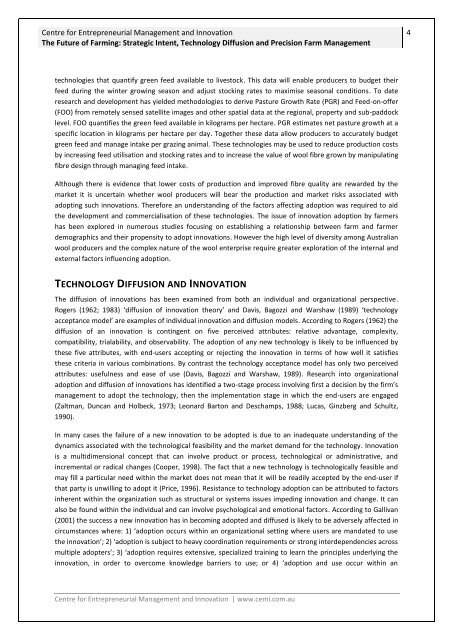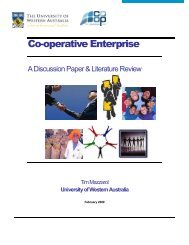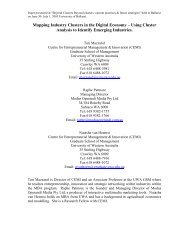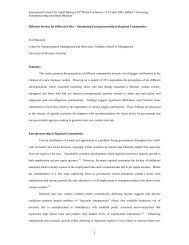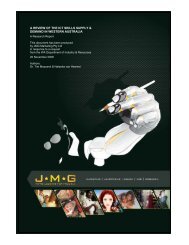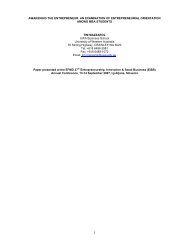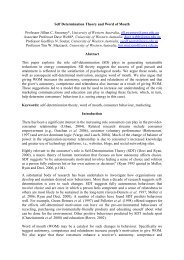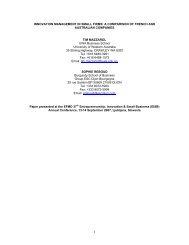The Future of Farming: Strategic Intent, Technology Diffusion ... - CEMI
The Future of Farming: Strategic Intent, Technology Diffusion ... - CEMI
The Future of Farming: Strategic Intent, Technology Diffusion ... - CEMI
You also want an ePaper? Increase the reach of your titles
YUMPU automatically turns print PDFs into web optimized ePapers that Google loves.
Centre for Entrepreneurial Management and Innovation<strong>The</strong> <strong>Future</strong> <strong>of</strong> <strong>Farming</strong>: <strong>Strategic</strong> <strong>Intent</strong>, <strong>Technology</strong> <strong>Diffusion</strong> and Precision Farm Management4technologies that quantify green feed available to livestock. This data will enable producers to budget theirfeed during the winter growing season and adjust stocking rates to maximise seasonal conditions. To dateresearch and development has yielded methodologies to derive Pasture Growth Rate (PGR) and Feed-on-<strong>of</strong>fer(FOO) from remotely sensed satellite images and other spatial data at the regional, property and sub-paddocklevel. FOO quantifies the green feed available in kilograms per hectare. PGR estimates net pasture growth at aspecific location in kilograms per hectare per day. Together these data allow producers to accurately budgetgreen feed and manage intake per grazing animal. <strong>The</strong>se technologies may be used to reduce production costsby increasing feed utilisation and stocking rates and to increase the value <strong>of</strong> wool fibre grown by manipulatingfibre design through managing feed intake.Although there is evidence that lower costs <strong>of</strong> production and improved fibre quality are rewarded by themarket it is uncertain whether wool producers will bear the production and market risks associated withadopting such innovations. <strong>The</strong>refore an understanding <strong>of</strong> the factors affecting adoption was required to aidthe development and commercialisation <strong>of</strong> these technologies. <strong>The</strong> issue <strong>of</strong> innovation adoption by farmershas been explored in numerous studies focusing on establishing a relationship between farm and farmerdemographics and their propensity to adopt innovations. However the high level <strong>of</strong> diversity among Australianwool producers and the complex nature <strong>of</strong> the wool enterprise require greater exploration <strong>of</strong> the internal andexternal factors influencing adoption.TECHNOLOGY DIFFUSION AND INNOVATION<strong>The</strong> diffusion <strong>of</strong> innovations has been examined from both an individual and organizational perspective.Rogers (1962; 1983) ‘diffusion <strong>of</strong> innovation theory’ and Davis, Bagozzi and Warshaw (1989) ‘technologyacceptance model’ are examples <strong>of</strong> individual innovation and diffusion models. According to Rogers (1962) thediffusion <strong>of</strong> an innovation is contingent on five perceived attributes: relative advantage, complexity,compatibility, trialability, and observability. <strong>The</strong> adoption <strong>of</strong> any new technology is likely to be influenced bythese five attributes, with end-users accepting or rejecting the innovation in terms <strong>of</strong> how well it satisfiesthese criteria in various combinations. By contrast the technology acceptance model has only two perceivedattributes: usefulness and ease <strong>of</strong> use (Davis, Bagozzi and Warshaw, 1989). Research into organizationaladoption and diffusion <strong>of</strong> innovations has identified a two-stage process involving first a decision by the firm’smanagement to adopt the technology, then the implementation stage in which the end-users are engaged(Zaltman, Duncan and Holbeck, 1973; Leonard Barton and Deschamps, 1988; Lucas, Ginzberg and Schultz,1990).In many cases the failure <strong>of</strong> a new innovation to be adopted is due to an inadequate understanding <strong>of</strong> thedynamics associated with the technological feasibility and the market demand for the technology. Innovationis a multidimensional concept that can involve product or process, technological or administrative, andincremental or radical changes (Cooper, 1998). <strong>The</strong> fact that a new technology is technologically feasible andmay fill a particular need within the market does not mean that it will be readily accepted by the end-user ifthat party is unwilling to adopt it (Price, 1996). Resistance to technology adoption can be attributed to factorsinherent within the organization such as structural or systems issues impeding innovation and change. It canalso be found within the individual and can involve psychological and emotional factors. According to Gallivan(2001) the success a new innovation has in becoming adopted and diffused is likely to be adversely affected incircumstances where: 1) ‘adoption occurs within an organizational setting where users are mandated to usethe innovation’; 2) ‘adoption is subject to heavy coordination requirements or strong interdependencies acrossmultiple adopters’; 3) ‘adoption requires extensive, specialized training to learn the principles underlying theinnovation, in order to overcome knowledge barriers to use; or 4) ‘adoption and use occur within anCentre for Entrepreneurial Management and Innovation | www.cemi.com.au


